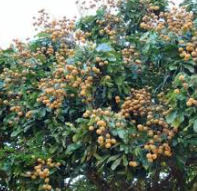Tannase Production from Different Strains of <i>Rhodotorula species</i> using <i>Chrysophyllum albidum</i> Seed Shell Flour as Substrate
Main Article Content
Abstract
Tannin is one of the major components of plants material. Tannase is an enzyme that breakdown tannin which is commonly implicated as an anti-nutritional factor in food and feed products. This study is aimed to determine the potential of Chrysophyllum albidum seed shell flour as substrate for microbial production of tannase. Rhodotorula species was isolated, screened and utilized for tannase production. A novel substrate, Chrysophyllum albidum seed shell flour, was unveiled for tannase production by solid state fermentation in this study. Six Rhodotorula species were isolated and characterized as Rhodotorula graminis, Rhodotorula rubra, Rhodotorula mucilaginosa, Rhodotorula minuta, Rhodotorula toruloides and Rhodotorula glutinis from thirteen soil samples obtained from different locations in Abeokuta, Ogun State, Nigeria. Only Rhodotorula mucilaginosa CBS 316, Rhodotorula toruloides strain bca-286 and Rhodotorula glutanis CBS20 were best tannase producers after screening and identification using molecular tools. Tannase activities from medium formulated with C. albidum seed shell flour were 542.45 U, 513.39 U and 489.50 U for R. mucilaginosa CBS 316, R. toruloides strain bca-286 and R. glutanis CBS20 respectively. Tannase activities were 610.75 U, 508.40 U and 485.85 U for R. mucilaginosa CBS 316, R. toruloides strain bca-286 and R. glutanis CBS20 respectively using medium formulated with wheat bran and sugar cane bagasse. This study indicated the potential of Chrysophyllum albidum seed shell flour as a novel substrate for tannase from strains of Rhodotorula species.
Metrics
Article Details

This work is licensed under a Creative Commons Attribution-NonCommercial 4.0 International License.
References
Kumar SK, Manjit S, Harsha N, Garima D. Role of Tannase in chronic diseases: a review. Res J Biotech. 2022; 17(1): 198–208.
Falcao L, Araujo MEM. Vegetable tannins used in the manufacture of historic leathers. Molecules. 2018; 23(5): 1081.
Smith AH, Zoetendal E, Mackie RI. 2005. Bacterial mechanism to overcome inhibitory effects of dietary tanins. ME. 2005; 50:197-205.
Lekshmi R, Arif NS, Thirumalai VP, Kaleeswaran B. A comprehensive review on tannase: microbes associated production of tannase exploiting tannin rich agro industrial wastes with special reference to its potential environmental and industrial applications. Environ Res. 2021; 201: 111625.
Famotemi AC, Afolayan TV, Fashola F, Ita B, Lawal AK. Comparative studies of three agro wastes for pectinase production and characterization by strains of Aspergillus niger. TJPPS. 2023;
Darah I, Ong CB, Jain K, Lim SH. Enhancement of tannase production on submerged fermentation by red yeast Rhodotorula glutinis DB2. J Pure Appl Microbiol. 2013; 7(3): 1525–1534.
Sadh PK, Duhan S, Duhan JS. Agro-industrial wastes and their utilization using solid state fermentation: a review. Biores. Bioproc. 2018; 5, 1.
Obi FO, Ugwuishiwu BO, Nwakaire JN. Agricultural waste concept, generation, utilization and management. Niger. J. Technol. 2016; 35 (4), 957–964.
Kareem SO, Famotemi AC, Oluwafemi F, Adewuyi S. Partial purification of pectinases from mutants of Aspergillus niger using Moringa oleifera. AJPAS. 8 (2019): 1-15.
Nofemele Z, Shukia P, Trussler A, Permul K, Singh S. Improvement of ethanol production from sugarcane molasses through enhanced nutrient supplementation using Saccharomyces cerevisiae. JIBD. 2012; 3:29-35.
Barnett JA, Payne RW, Yarrow D. Yeasts: Characteristics and identification. Cambridge University Press, Cambridge. 1990
Afolayan TV, Ada ME, Ibidapo OI, Orotope MO, Orji FA, Famotemi AC, Ehiwuogu-Onyibe J, Lawal AK. Screening and optimization of culture conditions for local production of tannase from fungal species. Trop J Nat Prod Res. 2020; 4(12):1178-1181.
Bradoo S, Gupta R, Saxena RK. Parametric optimization and biochemical regulation of extracellular tannase from Aspergillus japonicus. Process Bio-chem. 1997; 32: 135–139.
Sharma S, Bhat TK, Dawra RK. A spectrophotometric method for assay of tannase using rhodanine. Anal Biochem. 2000; 279:85–89.
Chaikaew S, Baipong S, Sone T, Kanpiengjai A, Chui-Chai N, Asano K. Diversity of lactic acid bacteria from Miang, a traditional fermented tea leaf in northern Thailand and their tannin-tolerant ability in tea extract. J. Microbiol. 2017; 55, 720–729.
Famotemi AC Lawal AK, Dike EN, Olatope SOA, Shittu KA, Itoandon EE, Kehinde MO, Orji FA, Elemo GN. Production of pectinase from strains of Aspergillus niger using corn pomace by solid state fermentation. Int. J. Adv. Res. Biol. Sci. 2015; 2(5): 93–99.
Camellia sinensis var. assamica collected in Northern Thailand and their tannin tolerance characterization. Front. Microbiol.2023; 14:1043430.
Zepf F, Jin B. Bioconversion of grape marc into protein rich animal feed by microbial fungi. Chem. Eng. Proc. Techniq. 2013; 1 (2), 1011.
Ushie OA, Adamu HM, Abayeh OJ, Chindo IY, Lawal U. Phytochemical screening of Chrysophyllum albidum leaf extracts. Journal of Applied Chemistry, 2014; 2(2):40-46.
MacDonald I, Nosa OO, Emmanuel OO, Joseph OE. 2014. Phytochemical and antimicrobial properties of Chrysophyllum albidum, Dacryodes edulis, Garcinia kola chloroform and ethanolic root extracts. J Inter. Ethnopharmacol. 2014; 3(1):15-20.


